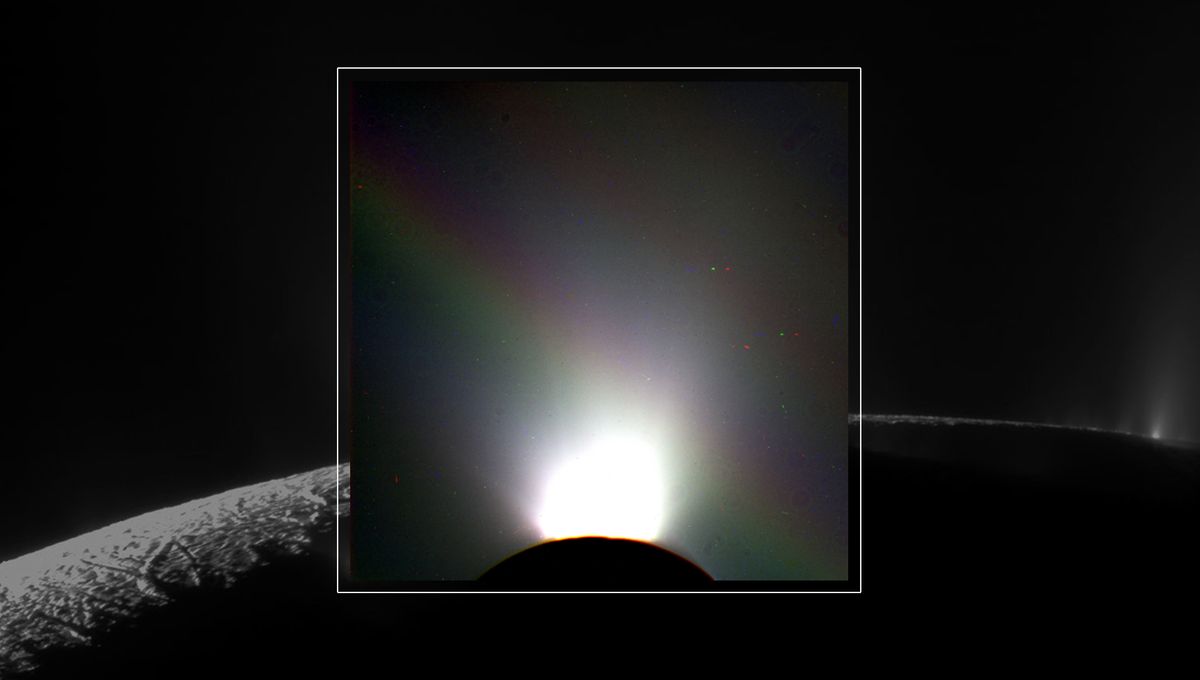
Astronomers have reported the discovery of an unlikely rainbow in the Solar System, showing that whenever there’s a bit of precipitation and light, rainbows appear. The celestial rainbow appears above Enceladus, the icy moon of Saturn, which is responsible for the formation of Saturn’s E ring.
The rest of this article is behind a paywall. Please sign in or subscribe to access the full content.
Enceladus is an active icy moon. When the international Cassini mission studied Saturn and its moons, it revealed that the diminutive Enceladus has a deep liquid ocean, with interesting chemistry that makes the moon a prime target for possible life. Enceladus has geysers on its southern pole, and the icy material they release ends up forming a wide and thick ring.
Researchers led by Niels Rubbrecht from Delft University have studied three flybys of Cassini, one in 2010 and two in 2012. They discovered that in photos from both the Imaging Science Subsystem (ISS) and the Visual and Infrared Mapping Spectrometer (VIMS), parallel stripes with a chromatic shift could be seen, creating a rainbow effect above Enceladus.
These stripes are tilted by 16° compared to the plane of the Sun and by 43° from Saturn’s ring plane. The stripes were visible across multiple images and were more clearly visible in infrared. All pointed to a physical effect rather than a camera artefact.
“The real challenge was trying to characterise what exactly we were seeing,” Rubbrecht said in a statement. “It wasn’t like anything documented before. Understanding the geometry, the light scattering, and ruling out other explanations took a lot of detective work across multiple disciplines.”
Their best explanation is that something is afoot in the E ring, and Enceladus might be responsible. There is an ordered reflective structure within the E ring that is creating these stripes. The material that it is made of seems to be fresh out of Enceladus, and the moon might also be shaping it, either due to magnetic field interactions or through the creation of density waves, called ice tendrils, that are caused by the highest velocity particles that erupt out of the little icy moon.
The density wave might just be caused by a perturbation from Enceladus’ gravity as it moves through the E ring. The team is not exactly sure just yet, but it seems that Enceladus is firmly in the midst of this brand-new phenomenon.
“Niels did an amazing job chasing rainbows around Saturn in the Cassini data. His findings suggest the presence of strangely organised material orbiting the planet, opening new avenues in planetary science and raising fascinating questions about how materials behave in extreme conditions,” added Rubbrecht’s supervisor and co-author, Dr Stephanie Cazaux.
Cassini was a collaborative mission by NASA, the European Space Agency, and the Italian Space Agency. It orbited Saturn for 13 years, delivering revolutionary insights. As this research proves, there are still many surprises to be found in its data.
The study is published in the journal Icarus.
Source Link: Enceladus Creates An Unlikely Rainbow Across One of Saturn’s Rings, Puzzling Astronomers